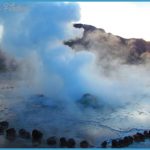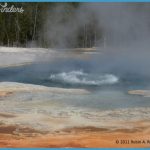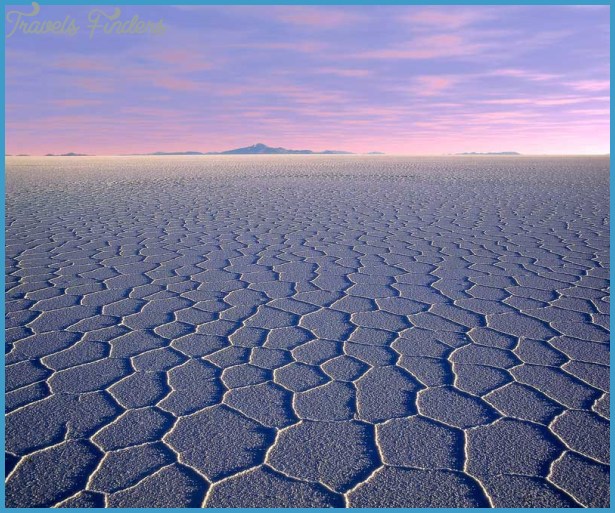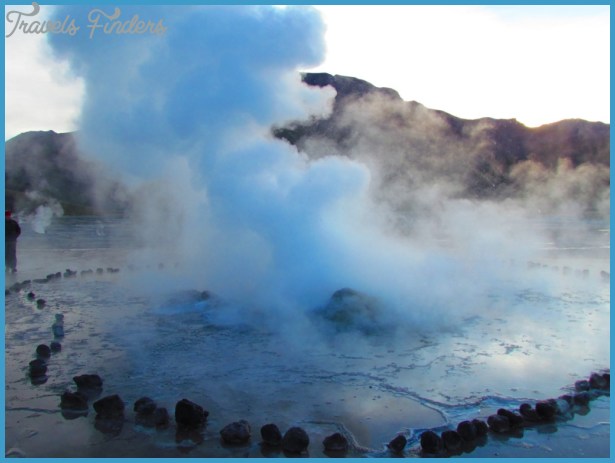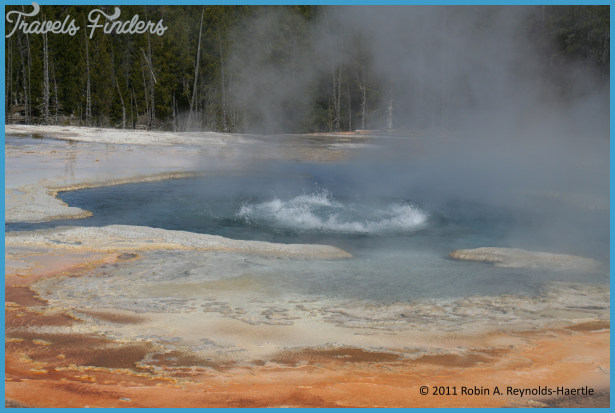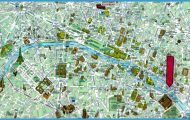Just over the bridge and partway up the hill begins the trail to observation Point, a climb of about 150 feet (45 m) in elevation in less than half a mile (0.8 km). Observation Point gives you an excellent view overlooking much of Upper Geyser Basin, and it’s a fine place to watch Old Faithful. You can continue to Solitary Geyser on this trail, which rejoins the Geyser Hill walkway, or you can retrace your steps down from Observation Point. Like Chinese Spring near Old Faithful Geyser, Solitary Geyser was misused in earlier days, but in this case, the misuse was ocially sanctioned. Its water was piped down to the Old Faithful Geyser Baths, across the Fire-hole River from Beehive Geyser, beginning in 1915. Its replacement, the Old Faithful Swimming Pool, was used until 1948.
Solitary Geyser now commonly erupts less than 6 feet (2 m) high every few minutes, and its water is definitely too hot for bathing! Solitary’s pool is surrounded by interesting geyserite egg formations. Back on the main walkway If you don’t go to Observation Point, climb the paved trail along the river and take the left fork (closer to the river) to walk around Geyser Hill and follow the route described here. (The walkway to the right is described in the other direction on s 97-98 and labeled (C) on the Upper Geyser Basin map.) The author learned to swim at the Old Faithful Swimming Pool, housed in this building. Sulphide Spring, the first feature on your right after the walkways split, lives up to its name by emitting a strong hydrogen sulphide odor, the smell of rotten eggs. The waters of Sulphide Spring and of nearby Infant Geyser are acidic, in contrast to the alkaline water typical of most Geyser Hill springs. Anemone Geyser (or Geysers) was named by geologist Walter Weed in the 1880s, but whether for the sea anemone or for the flower, no one is quite sure. The larger of the two vents, the one closer to the boardwalk, may erupt as often as every 7 to 10 minutes, unless an extended eruption of the smaller one increases the length of the intervals. It’s entertaining to watch the larger crater fill with water, begin splashing, erupt for a few seconds as high as 8 feet (2.5 m) then drain away with a sucking sound.
Plume Geyser, a short distance from Anemone and on the opposite side of the boardwalk, was created by a small steam explosion in 1922, then made itself a new vent in another explosion 50 years later. Plume plays up to 25 feet (7.5 m) in a plume or feathery jet that spews water at an angle about every hour. Plume is prone to some erratic behavior, including sleeping at night (erupting only in the daytime) and experiencing extended dormant periods. The eruptions of Beehive Geyser are a glorious sight but not really predictable. Nonetheless, the activity of an indicator geyser a few feet away sometimes gives ranger-interpreters a chance to alert visitors to an impending eruption. Although not totally reliable, the indicator has been noted in writings about the park since 1875 or earlier. It usually starts erupting 10 to 25 minutes before Beehive, allowing people around the visitor center to get to Geyser Hill or at least to the viewing benches north of Old Faithful and next to the river in time for the eruption. Beehive erupts once or twice a day for about 5 minutes. Historian Hiram Chittenden wrote of Beehive in the late 19th century: The symmetry of its cone is only surpassed by the regularity of its water column. From an artistic point of view it is the most perfect geyser in the Park. Beehive’s needle of water is breathtaking even from a distance; the roar of the steam is an extra thrill when you’re standing close.
As you leave Beehive, there are several minor geysers to your right (northeast) above the boardwalk. All are dicult to see and not currently active, though they may bubble or steam. Beehive Geyser jets 150 to 200feet (45 60 m). Depression Geyser’s blue-green pool looks quiet until it erupts 6 to 10 feet (2-3 m); this happens about every 6 hours. Arrowhead and Heart springs are quiet pools whose shapes illustrate their names, except that Arrowhead may have got its name from a Native American artifact found within it. The Lion Geyser Group has four cones. The largest and closest to the boardwalk is Lion Geyser. It roars like a lion when it gushes steam from its vent before all but the first of its cyclic eruptions, and its formation looks to some like a reclining lion when seen from the south. Farther back from the boardwalk, right to left as you stand near Lion, are Big Cub Geyser, Lioness Geyser, and Little Cub Geyser. Lion has 5- or 6-minute eruptions up to 70 feet (21 m) and always plays in a series of eruptions spaced 1 to 1.5 hours apart. In the past 10 years its mean between cycles has increased from about 9 to 15 hours. Lioness and Big Cub have been inactive in recent years but sometimes boil vigorously, while Little Cub erupted frequently to 10 feet (3 m) but slowed in 2006.
The washed look of Little Cub’s formation told you it was a frequent geyser, never dormant, in fact, in the history of the park. In 1889 a British visitor toured the Upper Geyser Basin, noted the pretty and fanciful names assigned to all the geysers, and wrote about the group you see here: The first mound that I encountered belonged to a goblin splashing in his tub. I heard him kick, pull a shower-bath on his shoulders, gasp, crack his joints, and rub himself down with a towel; then he let the water out of the bath, as a thoughtful man should, and it all sank down out of sight till another goblin arrived. Yet they called this place the Lioness and the Cubs. The visitor was the 24-year-old Rudyard Kipling. Goggles Spring and North Goggles Geyser are just beyond the Lion Group. Around North Goggle’s cone, note the interesting formation of geyserite eggs, built up during its sometimes impressive but very irregularly occurring eruptions. To turn back toward Old Faithful, take the right-hand fork at the walkway intersection (see s 97-98 for the features you will see). Heading away from Geyser Hill, the main path now takes you through the trees along the Firehole River.
You pass nondescript thermal pools, one called Frog Pond, because it actually has frogs in the spring, and Liberty Pool. The last spring was named after its first eruption on July 4, 1887. Across the river, Sprinkler Geyser may be spouting, as it does at least half the time. Tardy Geyser is the first one you encounter in a group called the Sawmill Geyser Complex. The underground plumbing of Tardy and several other geysers is connected in an exchange of function with Sawmill Geyser, so that members of the group influence each other’s eruptions. Look closely when the water in Tardy’s crater is low, and you can see uniform coin- or biscuit-shaped geyserite knobs around the edge, as you can also in Sawmill’s crater. Tardy’s eruptions are 10 to 15 feet (3-4.5 m) high. Sawmill Geyser is the tallest up to about 50 feet (15 m) and the longest erupting of the group. You’ll find it erupting about 30 percent of the time, with intervals between eruptions typically ranging from 1 to 3 hours. Its water spins about in a circle in the crater during eruptions, sounding like the moving wooden parts in an old water-powered sawmill. Behind Sawmill (to the west) is Uncertain Geyser, a small hole in Sawmill’s formation. Sometimes called Sawmill’s Satellite Vent, Uncertain erupts when others in the group are quiet, as high as 15 feet (45 m).
Solitary Geyser Side Loop Photo Gallery



